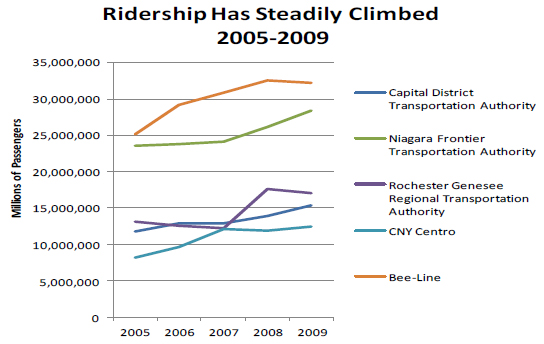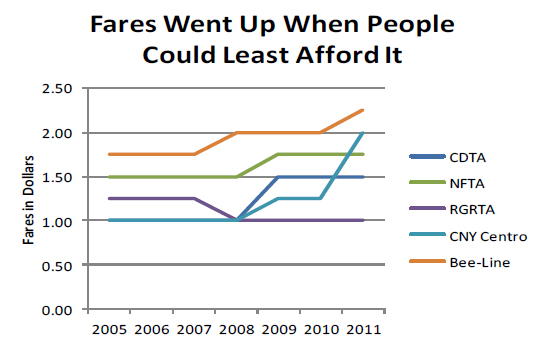
Funding cuts to non-MTA public transportation occurring between 2008 and 2011 have had a negative impact on transportation options for elderly and low-income New Yorkers, according to the results of a groundbreaking new report released by AARP and Tri-State today.
The study examined five public transit systems across New York State—Westchester, Albany, Syracuse, Rochester, and Buffalo—and revealed that ridership has risen, even as fares have climbed in the midst of a recession.
The report found that transit ridership steadily increased during the recession, indicating that people turn to transit when money is tight. The cost of owning a car and the high price of gas appear to have been contributing factors in this shift to transit. In 2009, for example, 77% of the Capital District’s CDTA riders said that they rode the bus because they didn’t have a car available, a figure that rose from a 2008 survey. AARP research has also shown that seniors are choosing public transit for an increasing share of their trips.

The study also found that while ridership increased, transit system operators have been squeezed by both decreased state and local funding and higher operating costs. Albany has repeatedly redirected funds earmarked for transit, and the only dedicated state funding source for non-MTA systems, the petroleum business tax, has not been raised since 2004. Because the tax does not rise or fall with the price of gas, revenues have stayed relatively flat over the years.
The report concludes that shrinking dollars for transit means shrinking options for those who can least afford it—including low-income residents, seniors, and other transit-dependent populations. However, the report also offers several ways to help fix this problem:
- Pass improved lockbox legislation (A9017-A/S6170-A) that would help stop diversions of transit funds statewide;
- Find revenue sources that will provide stable, reliable, and diverse funds to meet the growing demand for transit in the state;
- Increase the allocation of capital dollars to transit in NYSDOT’s capital plan and the NY Works Fund; and
- Promote policies, such as bus rapid transit, a type of bus service that enables shorter commutes, while better meeting the needs of New Yorkers.

[…] TSTC/AARP: Upstate Transit Cuts Hurt Seniors and Low-Income Residents (MTR) […]
[…] York have been especially painful for the state’s elderly and low-income families, reports Mobilizing the Region. And Green City Blue Lake is dubious of Cleveland’s number 10 ranking as a “great […]
The report recommends four items including BRT but you have dropped it here, why?
Thanks, Tom — the post has been updated.
[…] demand has come, in part from, transit systems in upstate New York who, as a result of Albany’s scaling back on transit operations funding, have begun utilizing reserve and capital dollars for operating costs just to keep bus systems […]
If you don’t have money, it’s really practical to just ride a transit. I don’t see anything wrong with that, especially with seniors who find it hard to drive by themselves.